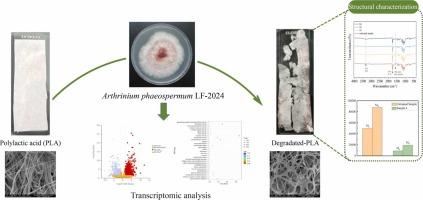Efficient degradation of polylactic acid plastics by a novel fungal strain Arthrinium phaeospermum and mechanistic insights
IF 11.3
1区 环境科学与生态学
Q1 ENGINEERING, ENVIRONMENTAL
引用次数: 0
Abstract
Polylactic acid (PLA) plastic, as an eco-friendly alternative to traditional petroleum-based plastics, is increasingly being used worldwide. However, improper handling and management of PLA have led to accumulation in the environment, resulting in pollution. The development of efficient PLA-degrading strains is crucial for reducing pollution. In this study, a fungus (Arthrinium phaeospermum LF2024) is isolated from landfill areas and its degradation characterization of polylactic acid (PLA) plastic is evaluated. The fungal treatment resulted in 42.1 ± 3.7 % mass reduction of PLA in 40 days incubation. The average molecular weight of PLA decreased significantly by 78.0 % after fungal treatment with the increased polydispersity. Degradation characterization revealed the structure of the PLA has been significantly destroyed after treatment by scanning electron microscopy, X-ray diffraction analysis, fourier transform infrared spectroscopy and thermogravimetric analysis and differential scanning calorimeter analysis, leading to a significant increase in the hydrophilicity of the PLA after fungal treatment, while its tensile strength decreased by 85 %. Transcriptomic analysis identified the involvement of Cytochrome P450, alcohol oxidase, lipases and cutinases in the fungal depolymerization of PLA. These findings highlight the potential of microbial methods for efficient PLA degradation, offering a sustainable approach to mitigate environmental impact and promote eco-friendly waste management.

一种新型真菌对聚乳酸塑料的高效降解及其机理研究
聚乳酸(PLA)塑料作为传统石油基塑料的环保替代品,在世界范围内得到越来越广泛的应用。然而,由于PLA的处理和管理不当,导致其在环境中积累,造成污染。开发高效的聚乳酸降解菌株对减少污染至关重要。本研究从垃圾填埋场中分离出一种真菌(Arthrinium phaeospermum LF2024),并对其对聚乳酸(PLA)塑料的降解特性进行了研究。真菌处理40 d后PLA质量降低42.1±3.7%。真菌处理后PLA的平均分子量显著降低78.0%,多分散性增加。通过扫描电镜、x射线衍射分析、傅立叶变换红外光谱、热重分析、差示扫描量热分析等手段对PLA进行降解表征,发现经过真菌处理后PLA的结构被明显破坏,导致PLA的亲水性显著提高,而拉伸强度下降了85%。转录组学分析发现细胞色素P450、醇氧化酶、脂肪酶和角质酶参与真菌解聚聚PLA。这些发现强调了微生物方法有效降解聚乳酸的潜力,为减轻环境影响和促进生态友好型废物管理提供了一种可持续的方法。
本文章由计算机程序翻译,如有差异,请以英文原文为准。
求助全文
约1分钟内获得全文
求助全文
来源期刊

Journal of Hazardous Materials
工程技术-工程:环境
CiteScore
25.40
自引率
5.90%
发文量
3059
审稿时长
58 days
期刊介绍:
The Journal of Hazardous Materials serves as a global platform for promoting cutting-edge research in the field of Environmental Science and Engineering. Our publication features a wide range of articles, including full-length research papers, review articles, and perspectives, with the aim of enhancing our understanding of the dangers and risks associated with various materials concerning public health and the environment. It is important to note that the term "environmental contaminants" refers specifically to substances that pose hazardous effects through contamination, while excluding those that do not have such impacts on the environment or human health. Moreover, we emphasize the distinction between wastes and hazardous materials in order to provide further clarity on the scope of the journal. We have a keen interest in exploring specific compounds and microbial agents that have adverse effects on the environment.
 求助内容:
求助内容: 应助结果提醒方式:
应助结果提醒方式:


